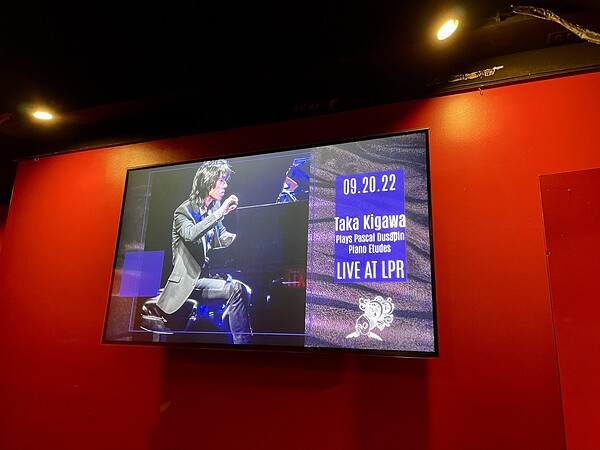Acclaim
Review
The Illusion of Cries and Whispers

“No one should be allowed to make music as if he were made of wood. One must reproduce the musical text exactly, but not play like a stone.”
Olivier Messiaen
Who knew that Pascal Dusapin had so many ardent fans?? I had never heard of the French composer. But apparently New Yorkers have a special affection for him. Le Poisson Rouge was packed solid, those sitting at tables nibbling at cupcakes or sipping ale, Elizabethan groundlings. Latecomers were turned away.
Pascal Dusapin obviously has either fervent acolytes or an underground cult!
Or–far more likely–tonight’s concert pulled in its ardent audience from the presence of that astonishing pianist, Taka Kigawa.
Astonishing, yes, first for his choices. An evening of Bach under his fingers has the same fascination as an evening of Pierre Boulez... or Pascal Dusapin. More important, because Mr. Kigawa brings not only unerring fingerwork, but an understanding. He never needs to “introduce” his music, or play down to his audience. His perceptions are those of a painter, whose colors or patterns don’t always make sense, but which inevitably draws a non-verbal emotion from the unprepared listener.
An hour of Pascal Dusapin’s Etudes deserved three modes of concentration. First, from the audience, forced to hang onto each note. Second, from Mr. Kigawa’s presence and care. I was sitting on the non‑keyboard side of the Yamaha, and Mr. Kigawa seemed to be playing the pedals like the keyboard itself. Every note deserve a half‑press, a quarter press, all the way down.
And third, Dusapin’s music itself. A student of both Messiaen and Xenakis, a one‑time jazz pianist–yet his music seemed to have no resemblance to either. We had no line, no continuo, variation nothing to which one could relate. Each etude was about eight minutes long. Yet orthodox patterns were either invisible or ephemeral.
In fact, the piano score (on YouTube) is as mesmeric as the music. Virtually every note had its own extreme dynamic. Two grace notes could be played together, one marked pppp, the second marked ffff. Yet listening, one felt a complete tapestry–though lacking warp or design.
These were not Webernian patterns. Nothing seemed serialized. Rather, Dusapin gave the impression of improvising these colors. For colors they were. If one looks at a Pointillistic painting from afar, it represents far more than their single points. Mr. Dusapin gives the points–but we rarely see the full picture.
We had a few exceptions. Etude 4, one of the only two virtuosic pieces, had a semblance of jazz rhythm, a scintilla of extemporization, But even the freest avant‑garde jazz is based on some kind of motifs. Perhaps not a melody, but a recognizable cell. Not here. The sliding fast notes, the trills, smacked of Tatum–but Tatum warming up looking for something interesting to play.
Dusapin was not drawing auditory pictures. But he came close in the Sixth Etude, with a single measure of...well possibly...a Middle Eastern mode. It lasted less than a second, but was so vaguely familiar (Whew!! A little life‑saver) that the rest of the etude appeared in my imagination as clothing on that Arabic cell, as if the composer took three notes, made them disappear and then pretended the notes were still there.
The end was surprising. The trills, the “shouts”, the quiet, was like the last measures of Sacre. Again my imagination.
But nothing is wrong with that. As Mr. Kigawa so carefully gave us whispers and shouts, the replica of bells (which were quickly vaporized), the facsimile of ostinatos, he never bothered to create a blatant pattern.
The only possible similitude to these Etudes would be the Játékok, the “games” of Győrgy Kurtág. But these bijoux had their own forms and recognitions. Pascal Dusapin and his executant Taka Kigawa never gave away these games.
In ordinary music, one can recognize constellations and solar systems. Last night, we heard quarks and beams and particles. And perhaps in their own cosmic way, perhaps that sufficed. Some music needs cries and whispers. Mr. Dusapin gave a fragmentary pretense for both.